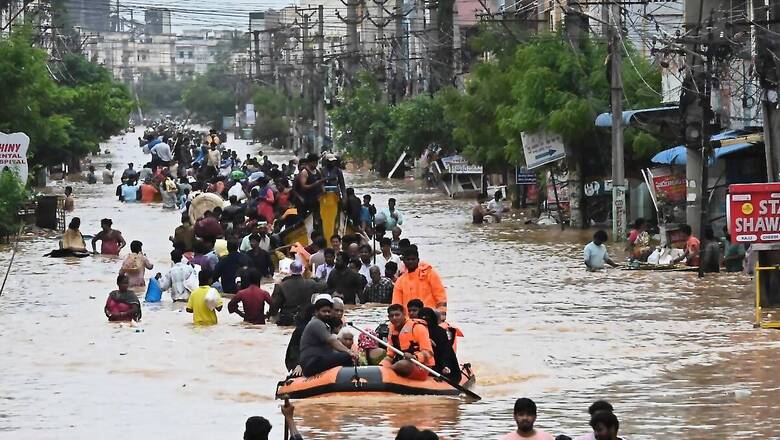
views
Over 45 per cent of the districts in India are alternating between floods and droughts as the southwest monsoon becomes more erratic under the effect of global warming, says a new study. The findings were released on Friday, just when large parts of Andhra Pradesh and Telangana are struggling to cope with severe monsoon flooding.
The team from IPE-Global and Esri-India compiled a catalogue of extreme climate events in India over a 50-year historical period from 1973 to 2023 using spatial and temporal modelling. The study provides additional evidence of how extreme weather events have increased in intensity, frequency and scale across India.
“The current trend of catastrophic climate extremes is a result of 0.6 °C temperature rise in the last century. Recent Kerala landslides triggered by incessant and erratic rainfall episodes, the floods in Gujarat, and the sudden and abrupt downpour in cities show how the climate has changed,” said lead author Abinash Mohanty, who leads the Climate Change and Sustainability Practice at IPE Global.
According to the district-level assessment — ‘State of Extreme Events’ — almost 85 per cent of the districts are now prone to extreme weather, with floods, droughts, cyclones and heatwaves increasing five-fold over the last decade.
CHANGING CLIMATE RISKS – FLOODS AND DROUGHTS
The report also throws light on the fast-changing climate-risk landscape of these districts with many drought-prone districts now struggling with floods. More than 60 per cent districts in Bihar, Andhra Pradesh, Odisha Gujarat, Rajasthan, Uttarakhand, Himachal Pradesh, Maharashtra, Uttar Pradesh, and Assam are witnessing more than one extreme climate event, it stated.
Several districts, including Srikakulum, Cuttack, Guntur, Kurnool, Mahbubnagar, Nalgonda, and Paschim Champaran, have become susceptible to both floods and droughts. The trend is also reversing for states like Andhra Pradesh, Tamil Nadu, and Karnataka which are becoming more drought-prone. Districts such as Rajkot, Surendranagar, Ajmer, Jodhpur, and Aurangabad have also faced both flood and drought conditions.
A key similarity in these hotspots was that almost all of them had undergone major changes in land-use/land-cover, deforestation, encroachments upon mangroves, and wetlands which rendered them vulnerable. The continuous increase in global greenhouse gases emissions, unplanned landscape planning and unsustainable construction activities have been the major triggers for these climate extremes.
WARMEST AUGUST GLOBALLY, SAYS EU CLIMATE SERVICE
The release of the report coincides with the latest statement from the Copernicus Climate Change Service of the EU concluding that August 2024 was the warmest globally (together with August 2023), with mean monthly temperature 0.71°C above the 1991-2020 average. The India Meteorological Department (IMD) also recently stated how India saw the highest-ever average night-time temperatures for August in almost a century — 0.6°C above normal.
“While India’s per capita Carbon dioxide emissions are 1/3rd that of global average and a fraction of the developed nations like the USA and China, it bears the brunt of climate change the most. But to meet climate goals, India must shift its budget focus from mitigation to adaptation. Current practices underfund climate resilience, risking long-term sustainability,” said Ashwajit Singh, Founder and Managing Director, IPE Global.
According to Agendra Kumar, Managing Director, Esri India, leveraging GIS technology can be crucial in mitigating these climate risks in the near-future.
“Building climate resilience requires maintaining a delicate balance of both climate adaptation and mitigation approaches. Geography is key for understanding these future climate projections for policy interventions as well as efficiently planning intervention approaches,” he said at the release of the report during the Climate Technology Summit organised by Esri-India and its partner IPE Global on Friday.
The study called for a comprehensive risk assessment at the hyper-local level and establishment of a Climate Risk Observatory (CRO), a risk-informed decision-making toolkit for decision-makers at all levels to support sustained investment into climate-resilient critical infrastructure.




















Comments
0 comment